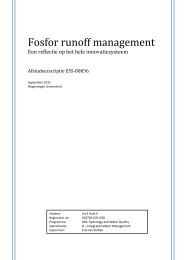Download PDF (English) - Future Ideas
Download PDF (English) - Future Ideas
Download PDF (English) - Future Ideas
You also want an ePaper? Increase the reach of your titles
YUMPU automatically turns print PDFs into web optimized ePapers that Google loves.
Master thesis Business Administration, Specialization: Strategy & Organization <br />
Supervisor: Prof. Dr. T. Elfring <br />
Joost de Boer <br />
Student number 1517597 <br />
Co-‐creation in the NPD-‐process <br />
The projects that the Club of Experts and Crowd of People were initiated to source for experiences and new <br />
ideas can mostly be redirected to the idea generation phase. In addition, also the Coalition of People was used <br />
to seek opportunities for possible cooperation between Company D and other organizations. For the selection <br />
of these generated ideas, several criteria were used. First, an idea was tested on its ‘fit’ with Company D: this <br />
was done to see whether it was close to Company D’s core business or not, as this gave a good indication on <br />
how easy the idea could be implemented in the existing organization. Also the content of the generated ideas <br />
appeared an important factor: “sometimes, it might be as easy as just turning a switch, and other ideas have <br />
more impact and therefore require more efforts.” <br />
Next, when the choice was to develop an idea inside the organization, the next question would be whether it <br />
would fit in one of the existing departments or that it needed a department on its own; this is of course <br />
dependent on the available competences and the expected impact an idea would have on the other <br />
businesses. When an idea was placed outside the organization, this involved a search for possible partner <br />
organizations. But, as the director business innovation explained: “These are of course beautiful models, who <br />
are theoretically valid, but in practice things just might go different than expected. It is dependent on many <br />
coincidences”. <br />
Considering the feedback that is provided to the stakeholders who participated in co-‐creation projects, the <br />
interviewees are kind of proud: “We have a tight connection between the sessions and the process afterwards. <br />
During the projects themselves, we already respond on ideas and indicate what we think of them by coding <br />
them with a certain color. After the projects, we often involve a group of people who were actively <br />
participating and bringing good ideas, by inviting them for an offline session, some sort of brainstorm. So we <br />
are quite involved in providing feedback and involving participants afterwards”, the director business <br />
innovation explains. <br />
Regarding the use of the Crowd of People for the purpose of internal co-‐creation, it is more difficult to redirect <br />
it to a certain phase in the NPD-‐process. Mostly because it had the purpose of process improvement, there was <br />
no obvious NPD-‐phase it could be placed in. Figure 4.8 illustrates the use of different types of co-‐creation, not <br />
directly placing the use of co-‐creation for internal sourcing in any of the phases. <br />
Figure 4.8 | Company D: types of co-creation and purpose in the NPD-process<br />
Crowd of People<br />
Idea Generation<br />
Idea Selection:<br />
Fit with business/<br />
departments<br />
Crowd of People<br />
Process improvement<br />
Topic<br />
defined by<br />
employees<br />
Club of Experts:<br />
Idea Generation<br />
Internal development<br />
No co-creation used<br />
Idea generation Idea development Idea diffusion<br />
49





